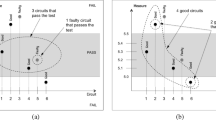Abstract
This paper presents fast and automated electromigration (EM) reliability modeling by using automated modeling generation (AMG) algorithm. The AMG converts human based EM modeling into an automated modeling and simulation process with the help of ANSYS parametric design language (APDL) program. For automating the neural model training process, training-driven adaptive sampling is applied to integrate data generation, data distributions determination, model structure adaptation, training and testing into a unified framework. Fully automated reliability model construction and simulation is achieved for the first time. This method effectively shortens the period of EM modeling by using dynamic sampling method. Furthermore, the heat generation from active devices has been considered to describe the heat effect on the interconnect reliability. Through the proposed technique, the allowable sizes, temperature and output power of a CMOS radio frequency power amplifier (RF PA) are derived to give reliability criteria for PA designer.









Similar content being viewed by others
References
Christou A (1993) Electromigration and electronic device degradation. Wiley, New York
Dalleau D, Zaage KW (2001) Three-dimensional voids simulation in chip metallization structures: a contribution to reliability evaluation. Microelectron Reliab 41(9/10):1625–1630
Devabhaktuni VK, Yagoub MCE, Zhang QJ (2001) A robust algorithm for automatic development of neural-network models for microwave applications. IEEE Transactions on Microwave Theory and Techniques 49(12):2282–2291
He FF, Tan CM (2012) Electromigration reliability of interconnections in RF low noise amplifier circuit. Microelectron Reliab 52(2):446–454
Kabir H, Zhang L, Yu M, Aaen PH, Wood J, Zhang QJ (2010) Smart modeling of microwave devices. IEEE Microw Mag 11(3):105–118
Kim J, Yoon Y, Kim H, An KH, Kim W, Kim HW, Lee CH, Kornegay KT (2011) A linear multi-mode CMOS power amplifier with discrete resizing and concurrent power combining structure. IEEE J Solid State Circuits 46(5):1034–1048
Lee O, An KH, Kim H, Lee DH, Han J, Yang KS, Lee CH, Kim H, Laskar J (2010) Analysis and design of fully integrated high-power parallel-circuit class-E CMOS power amplifiers. IEEE Transactions on Circuits and Systems I: Regular Papers 57(3):725–734
Na WC, Zhang QJ (2014) Automated knowledge-based neural network modeling for microwave applications. IEEE Microwave and Wireless Components Letters 24(7):499–501
Rayas-Sanchez JE (2004) EM-based optimization of microwave circuits using artificial neural networks: the state-of-the-art. IEEE Transactions on Microwave Theory and Techniques 52(1):420–435
RGdman-White W, Lek MSL, Tenbroek BM, Uren MJ, Bunyan RTJ (1993) Direct extraction of MOSFET dynamic thermal characteristics from standard transistor structures using small signal measurements. Electron Lett 29(13):1180–1181
Ruberto M, Degani O, Wail S, Tendler A, Fridman A, Goltman G (2008) A reliability-aware RF power amplifier design for CMOS radio chip integration, in IEEE International Reliability Physics Symposium 536–540
Tan CM, He FF (2009) 3D circuit model for 3D IC reliability study, in10th international conference on thermal, mechanical and multi-physics simulation and experiments in microelectronics and microsystems. 7
Tan CM, Roy A (2007) Electromigration in ULSI interconnects. Materials Science and Engineering - A Review Journal (Elsevier) R58(1–2):1–75
Tan CM, Zhang G, Gan ZH (2004) Dynamic study of the physical processes in the intrinsic line electromigration deep submicron copper and aluminum interconnects. IEEE Trans Device Mater Reliab 4(3):450–456
Tian YZ, He FF, Zhang QJ, Tan CM, Ma JG (2014) Rapid ULSI interconnect reliability analysis using neural networks. IEEE Trans Device Mater Reliab 14(1):400–407
Acknowledgements
This work was supported in part by the 863 Program of China (Contract No. 2015AA01A703) and the National Natural Science Foundation of China (Contract No. 61504092) and the Tianjin Research Program of Application Foundation and Advanced Technology (Contract No. 15JCQNJC01200).
Author information
Authors and Affiliations
Corresponding author
Additional information
Responsible Editor: T. Xia
Rights and permissions
About this article
Cite this article
Gu, J., Fu, H., Na, W. et al. Fast and Automated Electromigration Analysis for CMOS RF PA Design. J Electron Test 33, 133–140 (2017). https://doi.org/10.1007/s10836-016-5639-4
Received:
Accepted:
Published:
Issue Date:
DOI: https://doi.org/10.1007/s10836-016-5639-4




